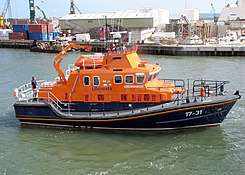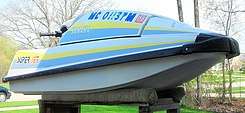Watercraft
Watercraft, also known as water vessels or waterborne vessels, are vehicles used in water, including boats, ships, hovercraft and submarines. Watercraft usually have a propulsive capability (whether by sail, oar, paddle or engine) and hence are distinct from a simple device that merely floats, such as a log raft.
.jpg)
Types
Most watercraft would be described as either a ship or a boat. However, there are numerous craft which many people would consider neither a ship nor a boat, such as: surfboards (when used as a paddle board), underwater robots, seaplanes, and torpedoes.
Although ships are typically larger than boats, the distinction between those two categories is not one of size per se.
- Ships are typically large ocean-going vessels; whereas boats are smaller, and typically travel most often on inland or coastal waters.
- A rule of thumb says "a boat can fit on a ship, but a ship can't fit on a boat", and a ship usually has sufficient size to carry its own boats, such as lifeboats, dinghies, or runabouts.
- Local law and regulation may define the exact size (or the number of masts) that distinguishes a ship from a boat.
- Traditionally, submarines were called "boats", perhaps reflecting their cramped conditions: small size reduces the need for power, and thus the need to surface or snorkel for a supply of the air that running marine diesel engines requires; whereas, in contrast, nuclear-powered submarines' reactors supply power without consuming air, and such craft are large, much roomier, and classed as ships in some navies.
- A merchant ship is any floating craft that transports cargo for the purpose of earning revenue. In this context, a passenger ship's "cargo" is its passengers.
The term "watercraft" (unlike such terms as aircraft or spacecraft) is rarely used to describe any individual object: rather the term serves to unify the category that ranges from jet skis to aircraft carriers. Such a vessel may be used in saltwater and freshwater; for pleasure, recreation, physical exercise, commerce, transport or military missions.
Usage

Usually the purposes behind watercraft designs and skills are for seafaring education or leisure activities, fishing and resource extraction, transportation of cargo or passengers, and for conducting combat or salvage operations. In general, the purpose of a water vehicle identifies its utility with a maritime industry sub-sector.
Design
The design from which a water vehicle is created usually seeks to achieve a balance between internal capacity (tonnage), speed and seaworthiness. Tonnage is predominantly a consideration in transport operations, speed is important for warships, and safety is a primary consideration for less experienced or often smaller and less stable training and leisure vehicles. This is due to the great level of regulatory compliance required by the larger watercraft, which ensures very infrequent instances of foundering at sea through application of extensive computer modeling and ship model basin testing before shipyard construction begins.
Propulsion
Historically, water vehicles have been propelled by people with poles, paddles, or oars, through manipulation of sails that propel by wind pressure and/or lift, and a variety of engineered machinery that create subsurface thrust through the process of internal combustion or electricity. The technological history of watercraft in European history can be divided by reference to marine propulsion as simple paddle craft, oared galleys from the 8th century BCE until the 15th century, lateen sail during the Age of Discovery from the early 15th century and into the early 17th century, full rigged ships of the Age of Sail from the 16th to the mid 19th century,[1] the Age of Steam reciprocating marine steam engine roughly between 1770 and 1914, the steam turbine, later gas turbine, and internal combustion engines using diesel fuel, petrol and LNG as fuels from the turn of the 20th century, which have been supplemented to a degree by nuclear marine propulsion since the 1950s in some naval watercraft. Current technological development seeks to identify cheaper, renewable and less polluting sources of propulsion for watercraft of all shapes and sizes.
Construction

Secondary applications of technology in watercraft have been those of used structural materials, navigation aids; and in the case of warships, weapon systems. The purpose of usage and the physical environment define the materials used in construction which had historically included grasses, leather, timbers, metals combined with timber or without, silicate and plastic derivatives, and others.
Registration

Watercraft registration is the registration of a watercraft with a government authority. In the United States, it consists of an alphanumeric string called a vessel registration number that is issued by the state's Department of Motor Vehicles.[2]
Navigation
Navigation aids have varied over time: from astronomical observation, to mechanical mechanisms, and more recently analogue and digital computer devices that now rely on GPS systems.
Weapons
Naval weapon systems have closely followed the development in land weapons, developing from:
- aircraft carriers
- breech-loading rifled guns
- direct enemy hull ramming to use of basic mechanical projectiles
- firing shells
- missiles and remotely piloted devices
- naval mine layers and minesweeper
- smooth-bore cannonball firing guns
- torpedo-armed submarines
- warships armed with fire control directed weapons
Until development of steam propulsion was coupled with rapid-firing breech-loading guns, naval combat was often concluded by a boarding combat between the opposing crews. Since the early 20th century, there has been a substantial development in technologies which allow force projection from a naval task force to a land objective using marine infantry.
See also
- Canal
- Ferry
- Glossary of nautical terms
- IMO numbers
- Lake freighter
- Maritime history
- Merchant vessel
- Navigability
- Roll-on/roll-off
- Ship registration
- Ship transport
- Train ferry
- Unmanned surface vehicle
- Waterway
References
- "The Age of Sail". HMS Trincomalee. Retrieved 12 April 2016.
- "Vessel Boat Registration and Information". State of California.
External links
| Look up watercraft or vessel in Wiktionary, the free dictionary. |
| Wikimedia Commons has media related to Watercraft. |